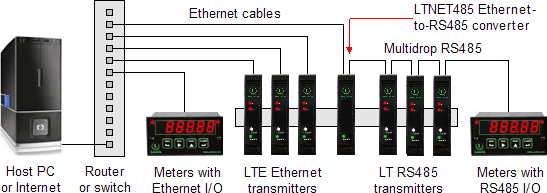
MLTE-R | Ethernet & 4-20 mA Output | Resistance in Ohms | DIN Rail Transmitter
The Micron Meters Resistance Transmitter is ideal for high-speed, high-accuracy resistance measurements in a production environment, such as contact resistance measurements. It is factory calibrated for five jumper selectable resistance ranges from 20.000 ohm to 200.00 kohm. Factory-special, fixed ranges of 2.0000 ohm or 2.0000 Mohm are also available. Accuracy is an exceptional ±0.01% of reading ± 2 counts. Resolution is one part in 20,000. In the 2 ohm range, resolution is 0.1 milliohm for contact resistance measurements.
Transmitter connections can be via 2, 3 or 4 wires. With 4-wire hookup, 2 wires are used for excitation and two separate wires are used to sense the voltage across the resistance to be measured, thereby eliminating any lead resistance effects. With 3-wire hookup, the transmitter senses the combined voltage drop across the RTD plus two excitation leads. It also senses the voltage drop across one excitation lead, and then subtracts twice this voltage from the combined total. This technique effectively subtracts the lead resistance if the excitation leads are the same.

All resistance ranges are digitally calibrated at the factory, with calibration factors stored in EEPROM on the signal conditioner board. This allows ranges and signal conditioner boards to be changed in the field without recalibrating the transmitter. If desired, the transmitter can easily be calibrated using external standards plus scale and offset in software.
High read rates at up to 60 or 50 conversions per second while integrating the signal over a full power cycle are provided by Concurrent Slope (US Pat 5,262,780) analog-to-digital conversion. High read rates are ideal for high-throughput manufacturing processes. Peak and valley values are automatically captured and may be displayed via a front panel push-button command or a control signal at the rear connector, or be transmitted as serial data.
Custom curve linearization, available with the Extended version, makes this transmitter suitable for use with transducers whose output is a non-linear changing resistance. Linearization is provided by curvilinear spline fits, and the reading can be scaled in software for user-selected engineering units of measure.
Transmitter connections can be via 2, 3 or 4 wires. With 4-wire hookup, 2 wires are used for excitation and two separate wires are used to sense the voltage across the resistance to be measured, thereby eliminating any lead resistance effects. With 3-wire hookup, the transmitter senses the combined voltage drop across the RTD plus two excitation leads. It also senses the voltage drop across one excitation lead, and then subtracts twice this voltage from the combined total. This technique effectively subtracts the lead resistance if the excitation leads are the same.

All resistance ranges are digitally calibrated at the factory, with calibration factors stored in EEPROM on the signal conditioner board. This allows ranges and signal conditioner boards to be changed in the field without re calibrating the transmitter. If desired, the transmitter can easily be calibrated using external standards plus scale and offset in software.
High read rates at up to 60 or 50 conversions per second while integrating the signal over a full power cycle are provided by Concurrent Slope (US Pat 5,262,780) analog-to-digital conversion. High read rates are ideal for high-throughput manufacturing processes. Peak and valley values are automatically captured and may be displayed via a front panel pushbutton command or a control signal at the rear connector, or be transmitted as serial data.
Standard features of Micron MLTE transmitters include:
- Ethernet I/O, isolated. Supported protocols are Modbus RTU and ASCII (tunneled via Modbus TCP) and Custom ASCII. The latter is simpler than the Modbus protocol and is recommended when all devices are Micron units. Note that RS232 or RS485 data I/O in lieu of Ethernet is provided by MLT Series transmitters.
- 4-20 mA, 0-20 mA or 0-10V analog transmitter output, isolated, jumper-selectable and user scalable. All selections provide 16-bit (0.0015%) resolution of output span and 0.02% output accuracy of a reading from -99,999 to +99,999 counts that is also transmitted digitally. Output isolation from signal and power grounds eliminates potential ground loop problems. The supply can drive 20 mA into a 500 ohm (or lower) load for 10V compliance, or 10V into a 5K ohm (or higher) load for 2 mA compliance.
- Dual solid state relays, isolated. Available for local alarm or control. Rated 120 mA at 130 Vac or 180 Vdc.
- Universal 85-264 Vac power. Low-voltage 10-48 Vdc or 12-32 Vac power is optional.
Discovery and configuration of Laureate Ethernet Nodes is easily achieved with the Node Manager Software, and the discovered transmitters can then be programmed using the Instrument Setup Software. Both software's run on a PC under MS Windows and can be downloaded from this website at no charge.

Data Sheet | User Manual
